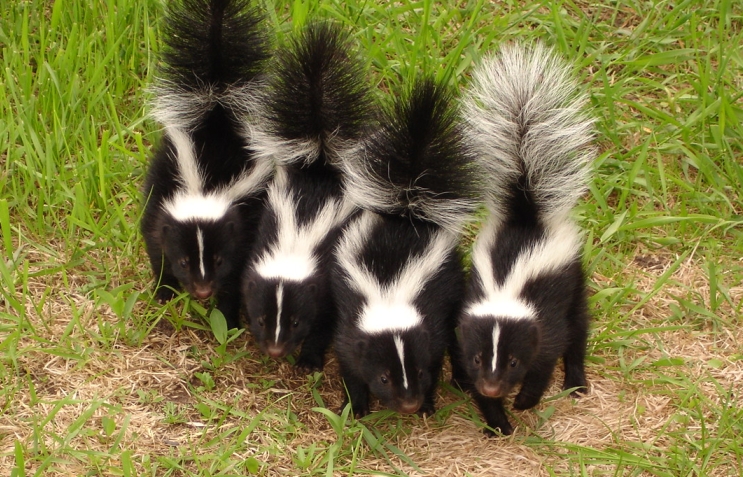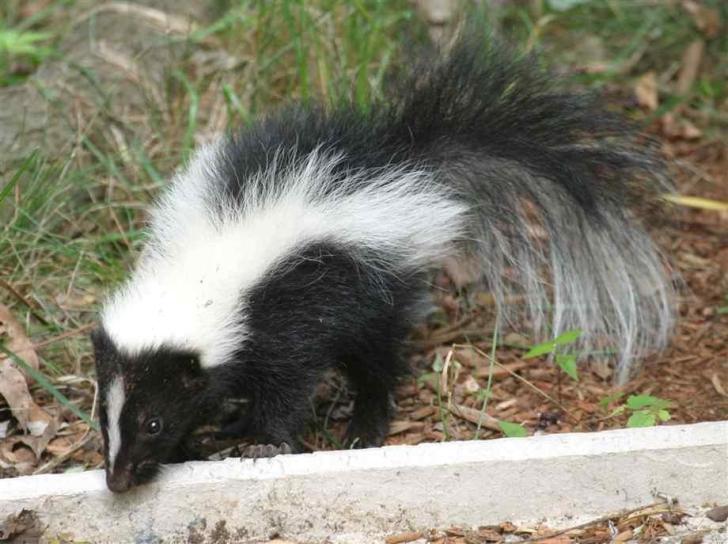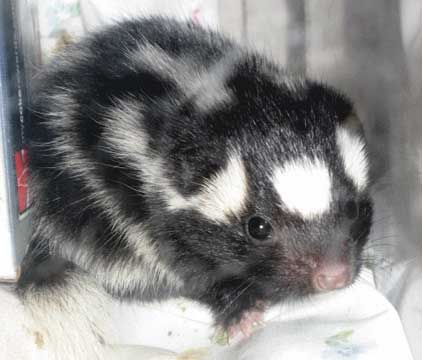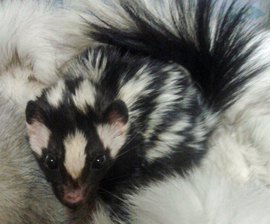Wouldn’t You Like To Hug Him?

He’s a white stripped blacky
What a cutie
When you get close
You will be stinky




Skunk OH!!
There are 12 species of skunks and most of them live in the United States. They eat mostly of insects. They like to dig holes in the ground and hunt for worms and grubs. But they will also eat small birds, frogs and mice and other such small creatures that they can find. They are well known for their bee-catching. They have such thick fur that they are not afraid of the bees stinging them, so they feast on the bees.
They have a defense mechanism that they spray on whatever of whoever gets into there business. They are not anxious to use this anytime because they have a limited supply of about 15 cc, which take about 10 days to replenish. This can be used four or five times before needing to be replenished so they will use other ways first to drive off predators such as stamping the feet and demonstrating hissing, tail high in the air and threat postures. How do you get rid of the smell if you do have a spray session?
Do you have to smell like rotten eggs and sulfur the rest of your life?
Mephitis, the genes name means “stench”. Spilogale putorius means "stinking spotted weasel". The different species vary in the shape of the body. Some are stripped and some are spotted. Their colors can be very black up to a dark brownish color or gray.
The male wanders by himself and has his own den but the females can be about ten of them huddled in a den together to keep warm during the coldest season. When a mother is going to have her kits she finds a place to make a den comfortable for the babies. She is good at taking care of her babies without the father and will spray at anything that she thinks could mean danger to her offspring.



Have a Nice Weekend
Have a nice weekend!” were wishes given us by family, neighbors and coworkers. Frank and I decided that we were not too old to actually car camp—that means taking a tent and sleeping bags in the trunk of the car, not an RV! It was early August and very hot in our hometown of Yuma, Arizona, so we thought of places not too far away that might be a little cooler for our weekend get away. Prescott, Arizona, was the chosen spot, so after saying a prayer for safety, as we always do before traveling, we set off on our journey. On arrival we selected campsite #1 at Yavapai Campground, just outside of Prescott, by Granite Mountain. We set up camp, had supper and went to bed; bed was a sleeping bag on a thin air mattress. Charlie, our little Terrier mix, who looks somewhat like the infamous Benji, lay at my feet. After tossing and turning and getting little sleep, we awoke to the pleasant, cool mountain air, chirping birds and beautiful surroundings of rock formations. It was so relaxing and enjoyable to sit in our folding lounge chairs, watching through binoculars the different species of birds and being able to identify them using the bird book that we had brought with us.
That evening we went into town to pick up a few forgotten supplies and decided that sunflower seeds would help attract more birds. Back at the camp we scattered sunflower seeds on the nicely landscaped retaining wall at our campsite. As we were putting things away and washing out our new pan, I went to dump the water on the other side of the retaining wall when I saw something move. I thought it must be Charlie, but what was he doing down there? When I took a second look, I saw that it was a black and white creature munching on sunflower seeds! I called to Frank, “Get in the car; it’s a skunk!” He fumbled around looking for the keys, and we finally made it to safety. But after a few minutes, Frank, who didn’t believe that I actually saw a skunk, went out to look. Yes, he confirmed that it really was a skunk! (And no, he didn’t get sprayed!)
We didn’t know that skunks like sunflower seeds but decided that maybe the sunflower seeds were not such a good idea, so I borrowed a broom from the camp host to sweep them up. It was dark by then, and on the way to the trash can to dispose of the seeds, our headlamps shined through the bushes ahead. All of a sudden there were two golden eyes staring back at us. That’s as far to the trash can as the sunflower seeds got, and we hightailed it back to the “safety” of our tent. The skunk was gone when we got back, so we settled down for the night, in our “half dome” tent, which is too low to stand up in.
We all three fell asleep in a short while, but I was awakened at about 3:00 a.m. to a low-pitched, deep growl outside the tent (on my side)! I tapped Frank and whispered to him that there was an animal outside, but he just kept snoring. I looked at Charlie and Charlie looked at me, and we both lay as still and quiet as two mice. When Frank finally woke up at about 4:00 a.m. we heard another loud snarl (still on my side of the tent). Frank yelled, “Get out of here!” and we never heard anything more.
By then it was impossible to go back to sleep, so at 5:00 a.m. we got up for the day and looked around the tent, but nothing was to be seen. The sun was up, and the weather was fresh and cool so we cooked our breakfast and talked about the events of the night. We guessed it might have been a bobcat, but when telling a ranger what happened he informed us that it was more than likely a mountain lion. It was so beautiful up there we had thought we would take one more day to enjoy it and had made arrangements to stay another night, but the closeness of skunks and a possible mountain lion encounter changed our minds. We packed our gear and arrived back home in Yuma safe and sound.
Our prayers for safety reminded us that, “The angel of the Lord encampeth round about them that fear him, and delivereth them.” Psalm 34:7.
“Be sober, be vigilant; because your adversary the devil, as a roaring lion, walketh about, seeking whom he may devour.” I Peter 5:8.
Bonnie Curtis-Gutierrez
